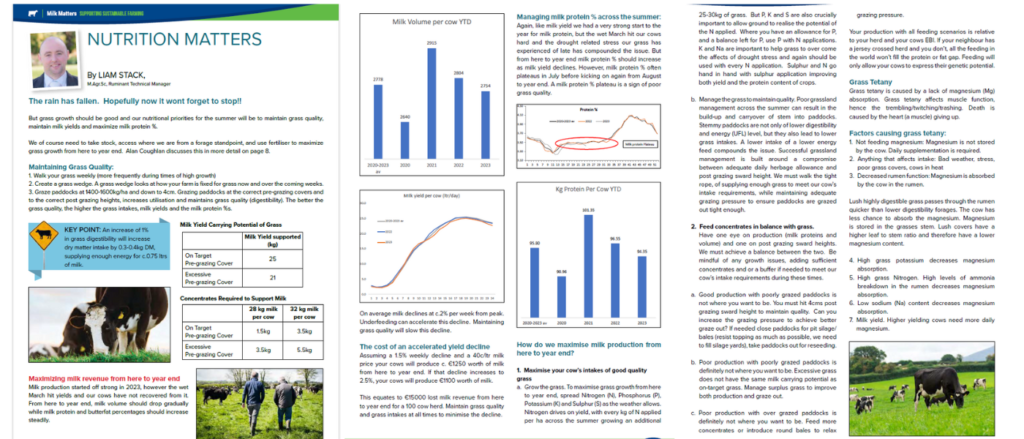Get a 24 hour weather forecast

The rain has fallen. Hopefully now it wont forget to stop!!
But grass growth should be good and our nutritional priorities for the summer will be to maintain grass quality, maintain milk yields and maximize milk protein %.
We of course need to take stock, access where we are from a forage standpoint, and use fertiliser to maximize grass growth from here to year end.
Maintaining Grass Quality:
The cost of an accelerated yield decline
Assuming a 1.5% weekly decline and a 40c/ltr milk price your cows will produce c. €1250 worth of milk from here to year end. If that decline increases to 2.5%, your cows will produce €1100 worth of milk. This equates to €15000 lost milk revenue from here to year end for a 100 cow herd. Maintain grass quality and grass intakes at all times to minimise the decline.
Managing milk protein % across the summer:
Again, like milk yield we had a very strong start to the year for milk protein, but the wet March hit our cows hard and the drought related stress our grass has experienced of late has compounded the issue. But from here to year end milk protein % should increase as milk yield declines. However, milk protein % often plateaus in July before kicking on again from August
to year end. A milk protein % plateau is a sign of poor grass quality.
How do we maximise milk production from here to year end?
Maximise your cow’s intakes of good quality grass.
Grow the grass. To maximise grass growth from here to year end, spread Phosphorus (P), Potassium (K) and Sulphur (S) as the weather allows. yield, with every kg of N applied per ha across the summer growing an additional 25-30kg of grass. But P, K and S are also crucially important to allow ground to realise the potential of the N applied. Where you have an allowance for P, and a balance left for P, use P with N applications. K and Na are important to help grass to over come the affects of drought stress and again should be used with every N application. Sulphur and N go hand in hand with sulphur application improving both yield and the protein content of crops.
Manage the grass to maintain quality.
Poor grassland management across the summer can result in the build-up and carryover of stem into paddocks. Stemmy paddocks are not only of lower digestibility and energy (UFL) level, but they also lead to lower grass intakes. A lower intake of a lower energy feed compounds the issue. Successful grassland management is built around a compromise between adequate daily herbage allowance and post grazing sward height. We must walk the tight rope, of supplying enough grass to meet our cow’s intake requirements, while maintaining adequate grazing pressure to ensure paddocks are grazed out tight enough.
Feed concentrates in balance with grass.
Have one eye on production (milk proteins and volume) and one on post grazing sward heights. We must achieve a balance between the two. Be mindful of any growth issues, adding sufficient concentrates and or a buffer if needed to meet our cow’s intake requirements during these times.
a. Good production with poorly grazed paddocks is not where you want to be. You must hit 4cms post grazing sward height to maintain quality. Can you increase the grazing pressure to achieve better graze out? If needed close paddocks for pit silage/ bales (resist topping as much as possible, we need to fill silage yards), take paddocks out for reseeding.
b. Poor production with poorly grazed paddocks is definitely not where you want to be. Excessive grass does not have the same milk carrying potential as on-target grass. Manage surplus grass to improve both production and graze out.
c. Poor production with over grazed paddocks is definitely not where you want to be. Feed more concentrates or introduce round bales to relax grazing pressure.
Your production with all feeding scenarios is relative to your herd and your cows EBI. If your neighbour has a jersey crossed herd and you don’t, all the feeding in the world won’t fill the protein or fat gap. Feeding will only allow your cows to express their genetic potential
Grass Tetany
Grass tetany is caused by a lack of magnesium (Mg) absorption. Grass tetany affects muscle function, hence the trembling/twitching/trashing. Death is caused by the heart (a muscle) giving up.
Factors causing grass tetany:
1. Not feeding magnesium: Magnesium is not stored by the cow. Daily supplementation is required.
2. Anything that affects intake: Bad weather, stress, poor grass covers, cows in heat
3. Decreased rumen function: Magnesium is absorbed by the cow in the rumen.
Lush highly digestible grass passes through the rumen quicker than lower digestibility forages. The cow has less chance to absorb the magnesium. Magnesium
is stored in the grasses stem. Lush covers have a higher leaf to stem ratio and therefore have a lower magnesium content.
4. High grass potassium decreases magnesium absorption.
5. High grass Nitrogen. High levels of ammonia breakdown in the rumen decreases magnesium
absorption.
6. Low sodium (Na) content decreases magnesium absorption.
7. Milk yield. Higher yielding cows need more daily magnesium.